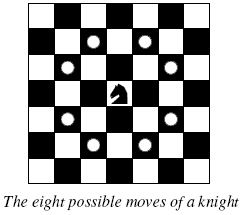A Knight's Journey
| Time Limit: 1000MS | Memory Limit: 65536K | |
| Total Submissions: 42114 | Accepted: 14324 |
Description
 Background
Background
The knight is getting bored of seeing the same black and white squares again and again and has decided to make a journey
around the world. Whenever a knight moves, it is two squares in one direction and one square perpendicular to this. The world of a knight is the chessboard he is living on. Our knight lives on a chessboard that has a smaller area than a regular 8 * 8 board, but it is still rectangular. Can you help this adventurous knight to make travel plans?
Problem
Find a path such that the knight visits every square once. The knight can start and end on any square of the board.
Input
The input begins with a positive integer n in the first line. The following lines contain n test cases. Each test case consists of a single line with two positive integers p and q, such that 1 <= p * q <= 26. This represents a p * q chessboard, where p describes how many different square numbers 1, . . . , p exist, q describes how many different square letters exist. These are the first q letters of the Latin alphabet: A, . . .
Output
The output for every scenario begins with a line containing "Scenario #i:", where i is the number of the scenario starting at 1. Then print a single line containing the lexicographically first path that visits all squares of the chessboard with knight moves followed by an empty line. The path should be given on a single line by concatenating the names of the visited squares. Each square name consists of a capital letter followed by a number.
If no such path exist, you should output impossible on a single line.
If no such path exist, you should output impossible on a single line.
Sample Input
3 1 1 2 3 4 3
Sample Output
Scenario #1: A1 Scenario #2: impossible Scenario #3: A1B3C1A2B4C2A3B1C3A4B2C4
题意:一个骑士,可以跳8个方向(和中国象棋的马类似,如图),给出一个n*m的矩阵,判断能否全都遍历一遍,能的话输出字典序最小的序列。
分析:
一看题目就是简单的dfs,只是要求输出字典序最小的序列,所以遍历顺序需要有所限制。
如图遍历即可得到字典序最小的序列。
代码如下:
#include <stdio.h>
#include <string.h>
int n,m;
int map[30][30];
char a[30][3];
int peace;
int dir[8][2]={{-1,-2},{1,-2},{-2,-1},{2,-1},{-2,1},{2,1},{-1,2},{1,2}};
void dfs(int t,int x,int y){
int i;
if(peace)
return ;
if(t>=n*m)
{
peace=1;
return ;
}
for(i=0;i<8;i++)
{
int px = x+dir[i][0];
int py = y+dir[i][1];
if(!map[px][py] && !(px<=0 || py<=0 || px>n || py>m) && !peace)
{
a[t][0]='A'+py-1;
a[t][1]=px+'0';
map[px][py]=1;
dfs(t+1,px,py);
map[px][py]=0;
}
}
}
int main()
{
int T;
int i,j;
int cnt = 0;
scanf("%d",&T);
while(T--)
{
memset(map,0,sizeof(map));
memset(a,0,sizeof(a));
scanf("%d %d",&n,&m);
peace=0;
map[1][1]=1;
a[0][0]='A';
a[0][1]='1';
dfs(1,1,1);
printf("Scenario #%d:\n",++cnt);
if(peace)
{
for(i=0;i<n*m;i++)
printf("%c%c",a[i][0],a[i][1]);
}
else
printf("impossible");
putchar('\n');
putchar('\n');
}
return 0;
}


























 8816
8816

 被折叠的 条评论
为什么被折叠?
被折叠的 条评论
为什么被折叠?








